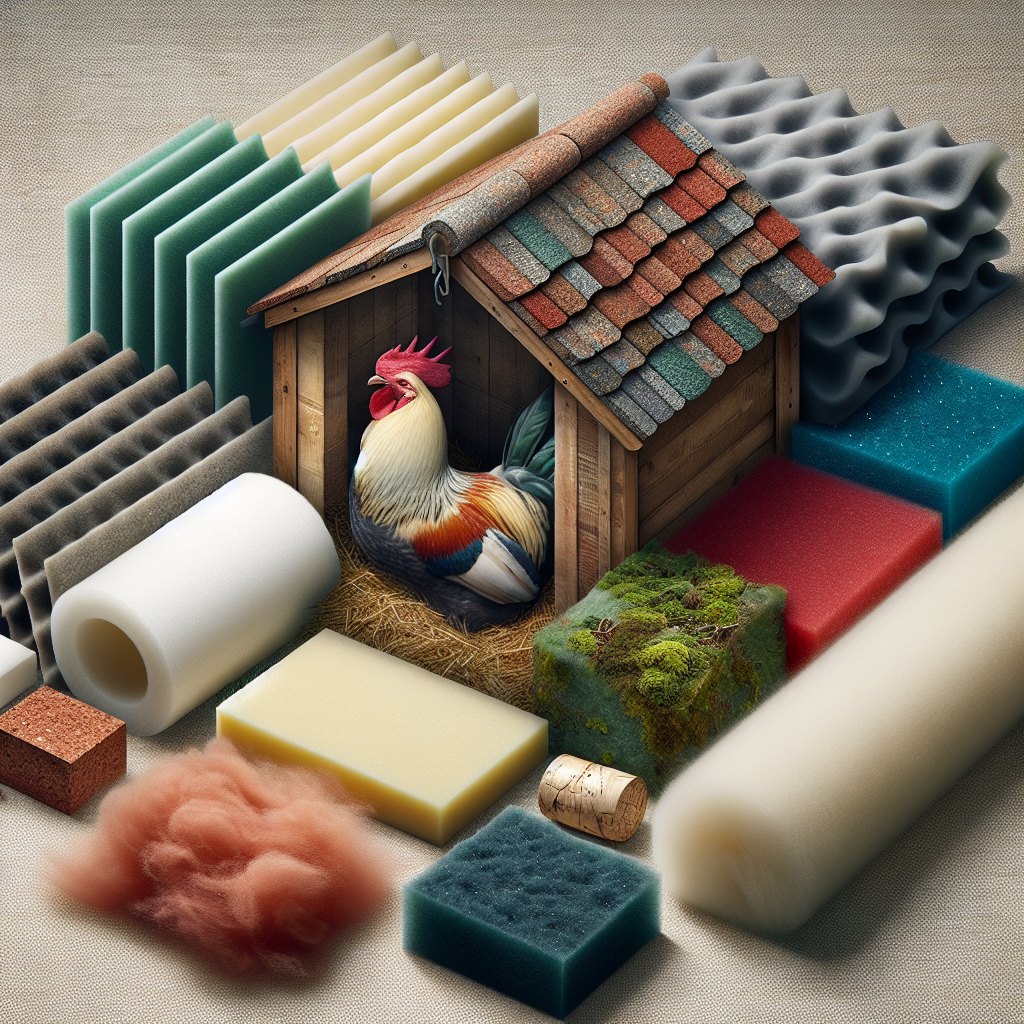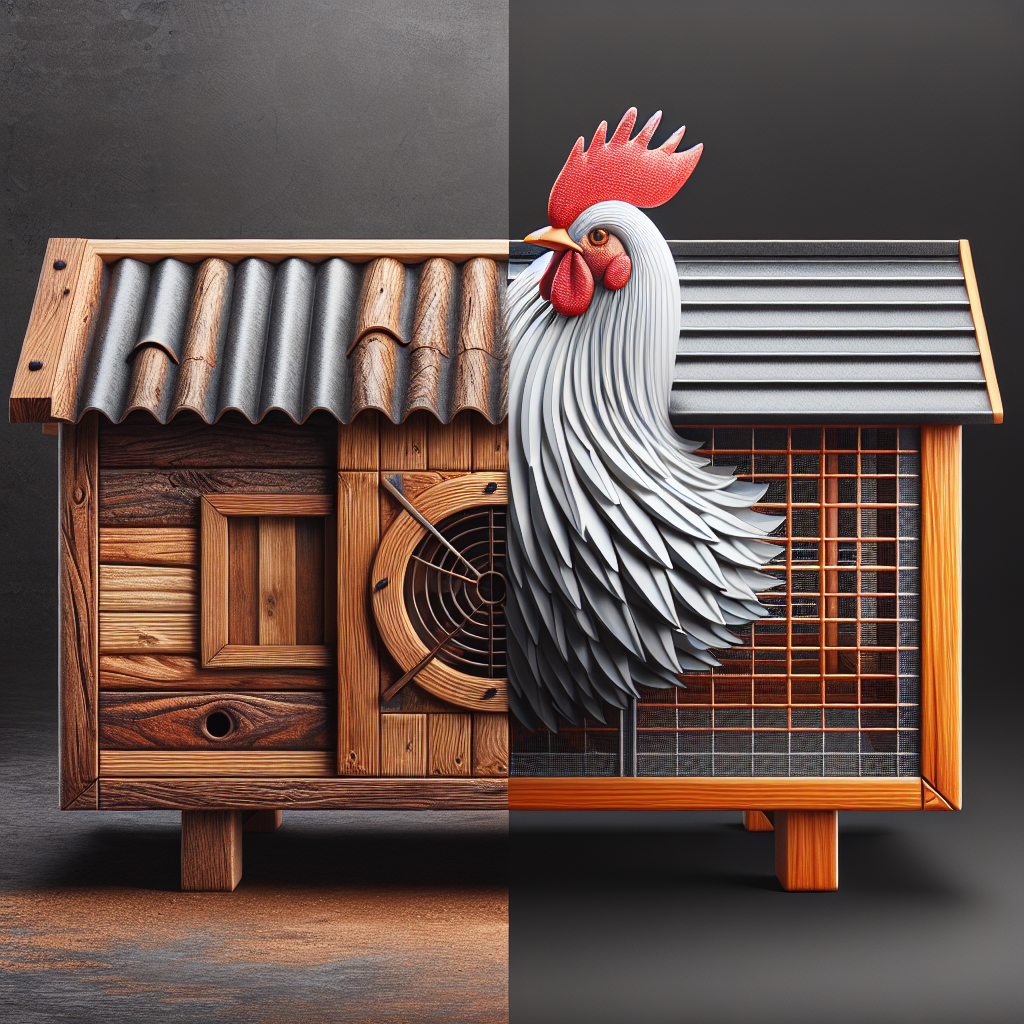Maintaining the longevity and durability of your chicken coop is essential for the well-being and safety of your feathered friends. In this article, we will explore and provide practical guidance on the recommended maintenance practices for various coop materials. Whether you have a wooden coop, a metal one, or even a plastic alternative, we have got you covered. By following these simple tips and tricks, you can ensure that your coop lasts for years to come, providing a secure and comfortable home for your beloved chickens. So, let’s get started!
Wooden Coops
Wooden coops are a popular choice for backyard poultry owners due to their natural and traditional appearance. To ensure the longevity of your wooden coop, proper cleaning and disinfecting are essential. Regularly removing debris, such as droppings and feathers, from both the interior and exterior of the coop will help prevent the buildup of harmful bacteria and pests. Use a gentle soap or a mixture of vinegar and water to clean the surfaces thoroughly, ensuring you pay close attention to cracks and crevices where dirt can accumulate. After cleaning, it is crucial to disinfect the coop using a poultry-safe disinfectant to eliminate any remaining pathogens.
Aside from regular cleaning and disinfection, inspecting the wooden coop for potential issues is vital. Check for any signs of rotting, such as soft or discolored wood, and promptly address these areas to prevent further damage. Additionally, examine the structure for loose or broken boards, ensuring they are promptly replaced or repaired as necessary. Regular inspections will help catch any potential problems early on, allowing you to take appropriate action and maintain the longevity of your wooden coop.
To further protect your wooden coop from environmental elements, treatment and protection methods should be applied. Applying a weather-resistant sealant or wood preservative will help protect the wood from moisture, UV rays, and pests. It is recommended to reapply these treatments annually or as directed by the manufacturer. By investing time in treating and protecting your wooden coop, you can significantly extend its lifespan.
Metal Coops
Metal coops offer durability and resistance to pests, making them a popular choice for many poultry owners. Cleaning and rust removal are critical in maintaining the longevity of metal coops. Start by removing any debris or droppings from the coop using a brush or hose. To remove rust, you can use a wire brush or sandpaper to scrub the affected areas gently. Ensure that all rust is thoroughly removed before proceeding.
Painting and coating the metal coop’s surfaces is the next step in maintaining its longevity. Apply a high-quality, poultry-safe paint or coating to protect the metal from corrosion, rust, and UV damage. It is crucial to choose paints and coatings specifically designed for outdoor use and safe for contact with animals. Follow the manufacturer’s instructions for the proper application process and drying time.
Regular inspections play a vital role in identifying any potential issues with your metal coop. Look for signs of corrosion, chipping paint, or areas where the coating may have worn off. Promptly address these areas by repainting, recoating, or repairing them to prevent further damage. By staying on top of regular inspections, you can catch and resolve any issues before they cause significant harm to your metal coop.
Repairing dents and gaps is crucial for maintaining the structural integrity of your metal coop. Small dents can often be fixed by gently hammering them back into shape, while larger dents may require more extensive repairs. It is important to address gaps, as they can leave your coop vulnerable to pests or drafts. Using appropriate materials, such as sheet metal or strong wire, repair any gaps to ensure the safety and longevity of your metal coop.
Plastic Coops
Plastic coops offer durability and easy maintenance, but they still require regular cleaning and care to ensure their longevity. Cleaning and sanitizing your plastic coop should be done regularly to prevent the buildup of bacteria and odors. Begin by removing any bedding, nesting materials, or waste from the coop. Use a gentle soap or a mixture of vinegar and water to clean all surfaces, including the floor, walls, and nesting boxes. Be sure to rinse thoroughly and allow the coop to dry before adding new bedding.
To protect your plastic coop from UV damage, it is essential to use products specifically designed for UV protection. UV-resistant sprays or coatings can be applied to the exterior surfaces of the coop to prevent fading, cracking, or weakening due to sun exposure. Be sure to follow the manufacturer’s instructions when applying these products for optimal results.
Regular inspections of your plastic coop are necessary to identify any signs of damage or wear. Look for cracks, breaks, or weakened areas that may compromise the structural integrity of the coop. Promptly repair or replace any damaged parts to prevent further deterioration.
In the event of cracks or breaks in your plastic coop, there are several ways to repair them. Depending on the extent of the damage, you may be able to use specialized plastic adhesives or sealants to fix minor cracks. For larger breaks or areas of severe damage, it may be necessary to replace the affected parts or seek professional assistance.
Wire Mesh Coops
Wire mesh coops provide great ventilation and visibility for your poultry while keeping them safe from predators. Regular cleaning is essential to maintain the hygiene of your wire mesh coop. Remove any droppings, dirt, or debris from both the interior and exterior of the coop using a brush or hose. Pay special attention to the corners and crevices where feces or other materials can accumulate.
Preventing rust and corrosion is crucial to ensure the longevity of your wire mesh coop. Over time, exposure to moisture can cause the mesh to rust, compromising its integrity. To prevent rust, consider applying a rust-resistant coating or using galvanized wire mesh when constructing the coop. Regularly inspect the mesh for any signs of rust and promptly address affected areas by removing the rust and applying a protective coating.
Regular inspections should be conducted to identify any signs of damage to the wire mesh. Look for holes, gaps, or areas where the mesh has become loose. These can be potential entry points for predators or pose a risk of escape for your poultry. Replace any damaged sections of the mesh promptly to ensure the security and longevity of your wire mesh coop.
Concrete Coops
Concrete coops offer durability and easy cleaning, making them a popular choice for poultry owners. Proper maintenance practices will help extend the lifespan of your concrete coop. Regular cleaning and sealing are key in keeping your concrete coop in excellent condition.
Cleaning your concrete coop involves removing any organic matter, such as droppings or bedding, that can accumulate on the floor. Use a brush or hose to scrub the surfaces and remove any debris. Once you have thoroughly cleaned the coop, allow it to dry completely before moving onto the sealing process.
Sealing your concrete coop will protect it from moisture and prevent the growth of mold or mildew. Choose a poultry-safe sealant specifically designed for concrete surfaces. Apply the sealant according to the manufacturer’s instructions, ensuring that all areas are adequately covered. Regularly reseal your concrete coop to maintain its longevity.
Inspecting your concrete coop for cracks is essential in preventing further damage. Look for any visible cracks in the walls or floor and promptly address them. Small cracks can often be filled with concrete patching material, while larger cracks may require professional assistance to repair. By proactively inspecting and repairing cracks, you can ensure the structural integrity of your concrete coop.
Fiberglass Coops
Fiberglass coops are lightweight, durable, and resistant to weathering, making them a practical choice for poultry owners. Proper cleaning and maintenance practices are essential to preserve the longevity of your fiberglass coop.
Cleaning your fiberglass coop can be done using a mild detergent or soap and water. Gently scrub the surfaces, removing any dirt, dust, or droppings. Rinse thoroughly to ensure all cleaning agents are removed, as residual soap can damage the fiberglass.
To maintain the appearance and protect the fiberglass from UV damage, consider polishing and waxing the surfaces. Choose a high-quality fiberglass polish and apply it according to the manufacturer’s instructions. This will help restore the shine and create a protective barrier against environmental elements. After polishing, apply a layer of wax designed for fiberglass surfaces to provide additional protection and shine.
Regularly inspecting your fiberglass coop is essential in identifying any cracks or scratches that may compromise its integrity. Inspect the surfaces, paying close attention to corners, joints, and areas prone to impact. If you notice any damages, promptly repair them using a fiberglass repair kit or seek professional assistance for more extensive repairs. By addressing damages early on, you can prevent further deterioration and ensure the longevity of your fiberglass coop.
Cement Board Coops
Cement board coops offer durability and resistance to moisture, but regular maintenance is still necessary to ensure their longevity. Cleaning and washing your cement board coop should be done using a mild detergent or soap and water. Scrub the surfaces for any dirt, droppings, or stains, and rinse thoroughly to remove all cleaning agents. Allow the coop to dry completely before inspecting for moisture damage or signs of wear.
Inspecting your cement board coop for moisture damage is crucial to prevent further deterioration. Check for any soft or discolored areas that may indicate water infiltration or rot. If you notice any signs of moisture damage, it is important to address them promptly. Remove and replace any damaged boards, ensuring that the new boards are properly installed and sealed. Regular inspections will help identify and address any potential issues, allowing you to maintain the longevity of your cement board coop.
Repairing or replacing damaged boards is essential to maintain the structural integrity of your cement board coop. Damaged or deteriorated boards can compromise the coop’s stability and protection against the elements. Using appropriate materials and techniques, replace any boards that are beyond repair and ensure a secure and weatherproof installation.
Regular inspections of your cement board coop will help ensure its long-term durability and functionality. Look for any signs of wear, cracks, or areas where the coating may have worn off. Promptly address these issues by repairing or replacing the affected areas. By staying proactive in your maintenance efforts, you can enjoy the benefits of a sturdy and long-lasting cement board coop.
Plywood Coops
Plywood coops offer a cost-effective solution for poultry owners, but they require regular maintenance to ensure their longevity. Cleaning and disinfecting your plywood coop are essential to maintain the hygiene of the environment. Remove any bedding, droppings, or debris from the coop and clean all surfaces using a mild disinfectant or a mixture of vinegar and water. Pay close attention to corners and crevices where bacteria can accumulate.
Inspecting your plywood coop for signs of rot or water damage is crucial for its longevity. Check for any soft or discolored areas that may indicate rot or water infiltration. Promptly replace any damaged plywood to prevent further deterioration and ensure the stability of the coop’s structure. Additionally, treating the plywood with a stain and sealant will provide added protection against moisture and UV damage.
Staining and sealing your plywood coop should be done regularly to maintain its longevity. Choose a high-quality stain that is specifically designed for exterior use and safe for animals. Apply the stain evenly to all exposed surfaces, following the manufacturer’s instructions. Once the stain has dried, apply a sealant to protect the wood from moisture and UV damage. Regularly inspect the stained and sealed surfaces for any signs of wear or damage, and reapply the stain and sealant as necessary.
The proper maintenance of plywood coops ensures the longevity of the structure while creating a healthy environment for your poultry. By following these maintenance practices, you can enjoy a sturdy and functional coop for years to come.
Brick or Stone Coops
Brick or stone coops offer durability and a classic aesthetic, but they still require regular maintenance to ensure their longevity. Cleaning and washing your brick or stone coop is essential to remove dirt, dust, and any organic matter that can accumulate on the surfaces. Use a mild detergent or soap and water to scrub the coop’s exterior, paying close attention to corners and crevices. Rinse thoroughly to ensure all cleaning agents are removed.
Repairing mortar joints is crucial in maintaining the integrity and appearance of your brick or stone coop. Over time, mortar can deteriorate, leading to gaps or loose bricks. Inspect the coop’s exterior for any signs of deteriorating mortar and promptly address these areas. Remove any loose or deteriorated mortar, and carefully apply new mortar to fill the gaps. It is important to use mortar that matches the original color and consistency for a seamless repair. Regularly inspecting and repairing mortar joints will help prevent further damage and ensure the longevity of your brick or stone coop.
Mold and mildew can also be common issues in brick or stone coops, especially in damp environments. Removing mold and mildew is important not only for aesthetic reasons but also for the health and safety of your poultry. Use a mixture of bleach and water, or a specific mold and mildew cleaner, to scrub the affected areas. Rinse thoroughly to remove any cleaning agents and allow the coop to dry completely before sealing and waterproofing.
Sealing and waterproofing your brick or stone coop will help protect it from moisture damage and prevent the growth of mold or mildew. Choose a high-quality sealant specifically designed for brick or stone surfaces. Apply the sealant according to the manufacturer’s instructions, ensuring that all surfaces are adequately covered. Regularly inspect the sealed and waterproofed areas for any signs of wear or damage and reapply the sealant as necessary.
By following these maintenance practices, you can enjoy a sturdy and visually appealing brick or stone coop that stands the test of time.
Composite Coops
Composite coops offer a modern and low-maintenance option for poultry owners. Although they are designed to resist environmental elements, regular maintenance is still necessary to ensure their longevity. Cleaning and washing your composite coop should be done using a mild detergent or soap and water. Gently scrub the surfaces to remove dirt, dust, and any organic matter. Rinse thoroughly to remove all cleaning agents.
Inspecting your composite coop for any signs of damage is essential to prevent further deterioration. Look for cracks, scratches, or areas where the composite material may have become weakened. Promptly repair or replace damaged parts to maintain the structural integrity of the coop. Additionally, regularly inspect the fasteners and connections, ensuring they are secure and tight.
Preventing mold and mildew is crucial in maintaining the cleanliness and appearance of your composite coop. Ensure that the coop is properly ventilated to minimize moisture buildup. If you notice any signs of mold or mildew, clean the affected areas using a mild detergent or a specific mold and mildew cleaner. Rinse thoroughly and allow the coop to dry completely before applying any preventive measures.
Repairing or replacing damaged parts of your composite coop should be done promptly to prevent further damage. Depending on the extent of the damage, you may be able to repair minor cracks or scratches using specialized composite repair kits. However, more extensive damage may require professional assistance or the replacement of entire sections. By addressing damages early on and taking appropriate action, you can ensure the longevity of your composite coop.




